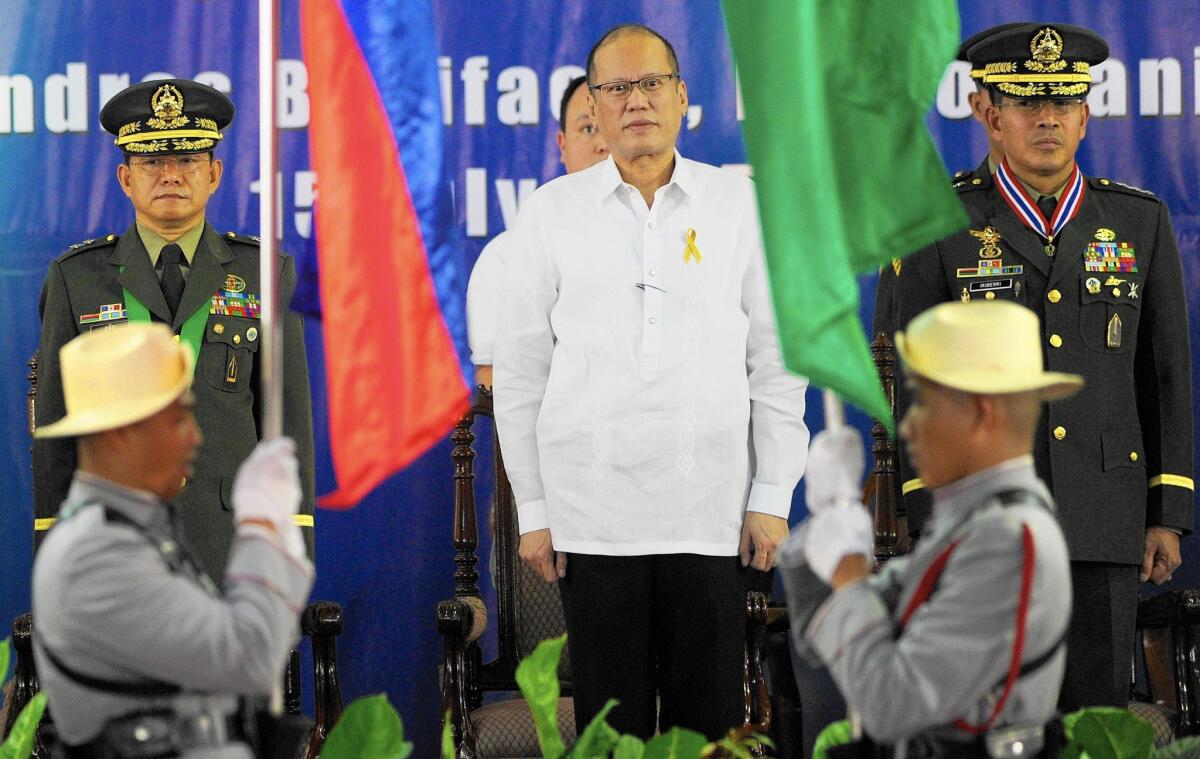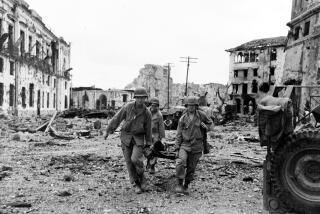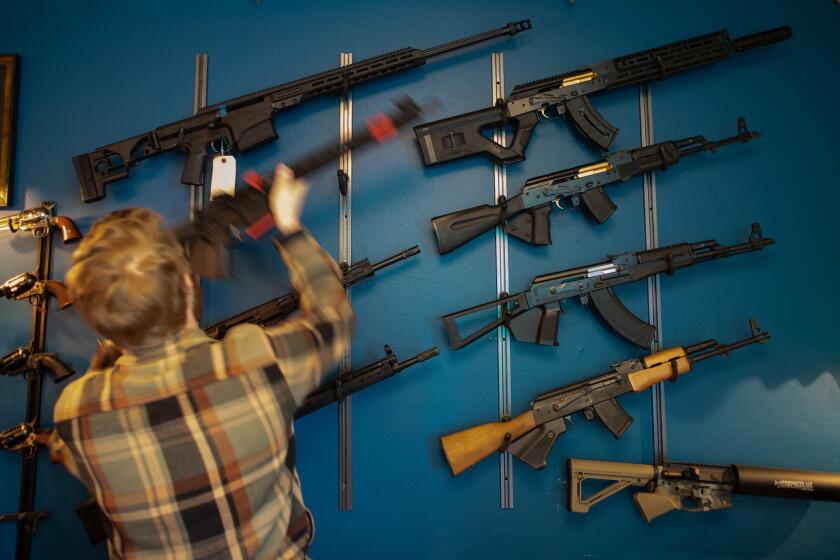A heavy price paid for botched terrorist raid by Philippines and U.S.

- Share via
Reporting from Manila — Before dawn on Jan. 25, a Philippine National Police commando team crept toward a thatched hut in the marshy jungles of Mindanao. They were hunting Marwan, an elusive bomb maker with a $5-million U.S. bounty on his head.
But they weren’t hunting alone.
Five or six U.S. counter-terrorism advisors assisted from a police command post nearby, tracking the assault team in live video from a U.S. surveillance aircraft circling overhead. “Their main role was to provide tactical, live intelligence,” said a Philippine officer who was present.
As the 13 commandos closed in, one stepped on a buried mine. The explosion wounded him and brought a burst of gunfire from the hut.
After a firefight, the American-trained team rushed in and radioed “Bingo, Mike One” to the command post. “Operation Exodus” appeared a success. The wispy-bearded target was dead.
To make certain, they sliced the right index finger off the corpse. DNA tests by the FBI later confirmed that it belonged to Marwan, nom de guerre for a Malaysian-born, U.S.-educated engineer linked to multiple terrorist attacks across Southeast Asia, including a 2002 bombing that killed 202 people in Bali, Indonesia.
But his death came at a dreadful cost: 44 police commandos and four civilians were killed, along with 17 militants, in a fierce daylong battle after the initial assault. The bloodshed triggered bitter recriminations in one of America’s closest allies in Asia, and put sharp new strains on Manila’s security relationship with Washington.
NEWSLETTER: Get the day’s top headlines from Times Editor Davan Maharaj >>
Within weeks, the Pentagon announced that it was withdrawing a special operations task force. It had been sent to the Philippines after the Sept. 11, 2001, terrorist attacks and had become a model for U.S. counter-terrorism teams later deployed around the globe.
Philippine President Benigno Aquino III’s government delayed plans to give U.S. troops, warships and aircraft wider access to military bases that the Obama administration sought for its strategic “pivot” to Asia. The planned expansion has been stalled since.
The botched raid also left a landmark 2014 peace deal between the Philippine government and entrenched Islamic rebels in tatters, sparking a renewal of violence by insurgent groups.
“It was a bungled operation and it has had major fallout,” said David Maxwell, a retired Army colonel who commanded the U.S. special operations force in the Philippines in 2006 and 2007.
This account is based on interviews with U.S. military officials and Philippine National Police officers, including survivors of the raid, as well as on formal inquiries by Philippine authorities, including a Senate committee and the Justice Department.
The U.S. “apparently gives us access to information and resources that have assisted us in our local operations,” the Senate panel concluded in March. “However the question is … who is driving the cart? Was the operation authored by Filipinos?”
Pentagon officials say the answer is clear: No Americans joined or issued orders to the assault team.
But the debacle marked an inglorious end to a little-known 13-year U.S. military advisory operation in the Philippines, an effort credited with improving its army and police and with reducing the number of insurgent groups.
At its height, five years ago, more than 600 U.S. special operations troops deployed to Muslim-dominated Mindanao, the second-largest island in the Philippines, according to Maj. Karolyn McEwen, a spokeswoman for U.S. Special Operations Command Pacific.
The U.S. force kept a low profile, working out of a base called Camp Navarro in western Mindanao. The government in Manila has battled Islamic separatist groups and communist insurgents on Mindanao for decades.
The Americans avoided a direct role in the fighting. They instead trained police and army units, advised them on counter-terrorism operations and ferried them around, sometimes in aircraft flown by U.S. contractors.
Over time, the U.S. focus increasingly turned to trying to capture or kill Marwan, who was believed hiding in western Mindanao. He became “HV1,” the highest value target in the Philippines.
See the most-read stories this hour >>
Zulkifli Abdhir, his real name, had been indicted in 2007 in U.S. District Court in the Northern District of California. The 16 charges included supplying bombs to Jemaah Islamiyah, a regional terrorist group that U.S. officials link to Al Qaeda, and Abu Sayyaf, a Philippine-based militant group that recently pledged allegiance to Islamic State.
Philippine authorities blamed Marwan for at least nine bombings since 2002 that left 46 people dead and 207 injured.
But helping them find the bomb maker proved maddening for the Americans. Security forces had launched nine unsuccessful operations against Marwan since 2006. But he got away each time.
His escapes raised suspicion that he was getting help from nearby Philippine soldiers, perhaps rebel fighters integrated into the army as part of reconciliation efforts.
When police received a promising tip in mid-2014 that Marwan was hiding in the remote area of Mamasapano,
the U.S. special operations task force helped track Marwan to a small house on stilts and began months of aerial surveillance.
U.S. military advisors supervised training of the police unit at a seaside resort and in the jungles of Mindanao before the raid. They also provided night-vision goggles, maps and a hand-held retinal scanner to confirm Marwan’s identity.
On the night of the assault, some of the police officers fell behind in crossing rivers and trekking down dark jungle trails. Only a third of the assault team had reached Marwan’s hut when the shooting started about 4 a.m.
Eager to get out, the team skipped the retinal scanner and cut off a finger instead, sticking it in a Ziploc bag.
But hundreds of Islamic fighters from other villages soon joined the battle. They pinned down the assault team and 350 other police officers who had deployed in the jungle to guard their escape.
“One by one we were getting hit and it slowed us down to carry the wounded,” said a police officer who survived the battle. “As the day went on, we felt helpless.”
U.S. advisors, relying on aerial video, helped some commandos “elude large enemy formations, thereby avoiding further casualties,” a police investigation found.
But the attackers spotted scores of police officers hiding in chest-high corn near Marwan’s hut and began raking the field with heavy machine gun and mortar fire. Most of the 44 dead were later found there.
After the 14-hour battle, a Black Hawk helicopter flown by Pentagon contractors landed and U.S. Army medics helped treat the wounded and collect the dead, U.S. officials said.
A few days later, Philippine police turned over the finger to an FBI agent in the city of General Santos on Mindanao. He rushed it off to the FBI laboratory in Quantico, Va.
The FBI had DNA from Rahmat Abdhir, a U.S. citizen who was arrested in Sunnyvale, Calif., in 2007 on charges of illegally sending $10,000, plus hand-held radios, Colt .45 magazines and other material to a designated terrorist — his older brother, Marwan — in the Philippines. Abdhir pleaded guilty to one count and is serving a 10-year sentence at the federal prison in Lompoc, Calif.
Two weeks later, the FBI issued its result: “After a thorough review of forensic data and information obtained from our Philippine law enforcement partners, the FBI has assessed that terrorism subject Zulkifli Abdhir, also known as Marwan … is deceased.”
Times staff writer Cloud reported from Washington and special correspondent De Leon from Manila.
ALSO:
Europe’s refugee trail: Bottlenecks ease in some places, remain in others
Hostage held by Islamists underscores China’s struggle with militants
Severe flooding in Japan washes away homes, strands dozens on rooftops
More to Read
Sign up for Essential California
The most important California stories and recommendations in your inbox every morning.
You may occasionally receive promotional content from the Los Angeles Times.











